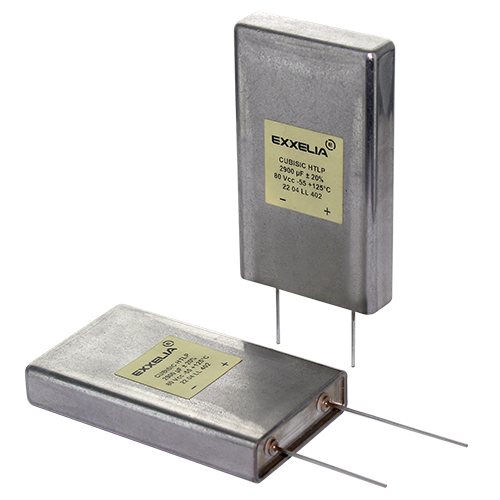CUBISIC HTLP : Exxelia étoffe sa gamme de condensateurs aluminium électrolytique de faible hauteur
Exxelia étoffe sa gamme de condensateurs Aluminium Électrolytiques de faible hauteur et défie les hautes températures à +125°C
7 juin 2022 – Paris, France - Exxelia, fabricant mondial de composants passifs complexes et de sous-systèmes dédiés aux environnements sévères, étoffe sa gamme de condensateurs CUBISIC, avec une version HTLP (High Temperature Low Profile). Ce CUBISIC HTLP offre, dans un packaging rectangulaire de faible épaisseur, la plus haute densité énergétique de condensateurs de sa catégorie, combiné à une tenue en température élevée (-55° → +125°C).
CUBISIC HTLP, la nouvelle gamme de condensateur rectangulaire qui change la donne

La nouvelle gamme de CUBISIC HTLP par Exxelia sort clairement du lot ! Pourquoi ?
- Elle offre jusqu’à 60% de plus de capacité que tous les autres condensateurs rectangulaires du marché, dans un même volume, tout en ayant une durée de vie de 5 000 heures.
- Couvrant une plage de température de -55° → +125°C, le CUBISIC HTLP est conçu pour offrir d’excellentes performances en températures extrêmes, compatible des applications militaires et aéronautiques les plus sévères.
Les ingénieurs se confrontant à des exigences de conception complexes et recherchant un produit facilement intégrable gagneront en encombrement et en fiabilité grâce à l’utilisation de matériaux améliorés et entièrement conformes à la norme REACH.
Le CUBISIC HTLP résiste à des vibrations de 20g et est qualifié à basse pression, le rendant résistant jusqu’à 92,000 pieds d’altitude. Il est parfaitement adapté pour une intégration dans les cockpits, les actionneurs et pour la génération d’énergie des avions commerciaux et militaires ainsi que dans les radars et systèmes laser.
CARACTÉRISTIQUES TECHNIQUES :
- Capacité de 140μF à 58 000μF
- Tension de 7,5V à 350V
- Durée de vie de 5 000 heures à 125°C
- Température de fonctionnement -55°C à +125°C
- 20g en vibrations et 92,000 pieds d’altitude
- Versions RoHS disponibles